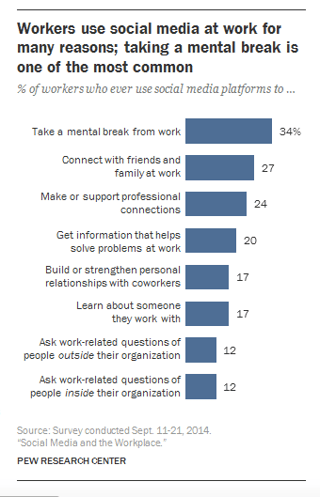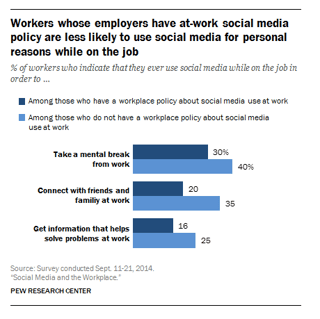October 21, 2016 | Mike Pumphrey
October 21, 2016 | Mike Pumphrey
Social media has taken society by storm, and it affects many areas of daily life, from communication and news consumption to parenting and work.
 Nearly two-thirds of American adults use social networking sites, according to social media usage tracking conducted by Pew Research Center. And more and more, workers are using social media while on the job for various reasons, ranging from taking a mental break to making professional connections. But social media use at work can also result in distractions and lost productivity.
Nearly two-thirds of American adults use social networking sites, according to social media usage tracking conducted by Pew Research Center. And more and more, workers are using social media while on the job for various reasons, ranging from taking a mental break to making professional connections. But social media use at work can also result in distractions and lost productivity.
There’s a fine line between the perks and the risks associated with social media use at work, though. While social networking sites can serve as platforms to connect with colleagues and discover resources for the job, there’s also the chance that employees are using these digital platforms for non-work purposes or to engage in dialogue that might reflect poorly on the company.
In the senior care space, specifically, there’s concern around patient privacy when it comes to the use of social media, and some companies have found themselves in media headlines for their employees’ irresponsible use of social media with respect to privacy.
As such, many employers have taken to implementing rules and policies around social media use at work, or about how employees can present themselves on their personal sites. Some examples include:
 In a Pew Research Center survey of 2,003 American adults, more than half of all full-time and part-time workers indicated their workplace has rules about using social media on the job, but 77% of workers report logging into their social media profiles despite restrictions in place.
In a Pew Research Center survey of 2,003 American adults, more than half of all full-time and part-time workers indicated their workplace has rules about using social media on the job, but 77% of workers report logging into their social media profiles despite restrictions in place.
Even so, there might be some level of efficacy in creating social media policies, especially when considering how workers subsequently use the platforms, the Pew Research Center survey found. For example, 30% of workers whose employers have an at-work social media policy use different platforms to take a break from the job, as compared to 40% of those whose employers haven’t instilled regulations.
The use of social media for personal-related purposes far outweighs use for work-related purposes, with only 14% reporting ever using LinkedIn for work-related purposes and 3% ever using Twitter.
Make Social Media Work for You
 Social media can be a distraction at work, but once your social media policy is firmly in place, there are ways you can make your employees’ Facebook or Twitter addiction benefit your organization.
Social media can be a distraction at work, but once your social media policy is firmly in place, there are ways you can make your employees’ Facebook or Twitter addiction benefit your organization.
Senior care is facing a workforce shortage, and many providers report difficulties recruiting workers. Employee referrals are a great way to build your talent pipeline. 79% of job seekers use social media in their job search, so increase your reach by co-opting your employees’ social networks
Provide employees with content about your organization that they can then post to their social feeds, or post content to your feeds that they can like and share. Don’t underestimate how you can amplify your brand among potential candidates with simple, short social media posts.
If you’re not sure what kinds of things to post, start with updates about resident events and social activities (make sure your posts include pictures). You can also praise employees for their good work by calling it out on your social feeds. Humor is always a good approach--funny posts are especially likely to be shared and go viral. And of course, ask your employees to share any open job postings.
While it’s important to have policies around social media and to make sure employees are following them, when used appropriately, social media can make a big difference in how you are perceived by potential employees and further engage your current employees.
Subscribe to the OnShift Blog
Recent Posts
Categories
About Mike Pumphrey
Mike Pumphrey is Vice President of Product Marketing at OnShift. His expertise in staffing and labor management strategies in long-term care and senior living is foundational to his role leading OnShift’s Product Marketing team. Mike works hand-in-hand with state and national associations, senior care providers, and with OnShift’s Customer Success and Product teams to create impactful best practices aimed to help solve the daily workforce challenges in senior care. Mike shares insights, research and recommendations to improve clinical, operational, and financial outcomes through regular blog posts and conference speaking engagements.
See for yourself why thousands of providers rely on OnShift’s innovative software for recruitment, hiring, workforce management, pay and engagement. Request your personalized demo today.
